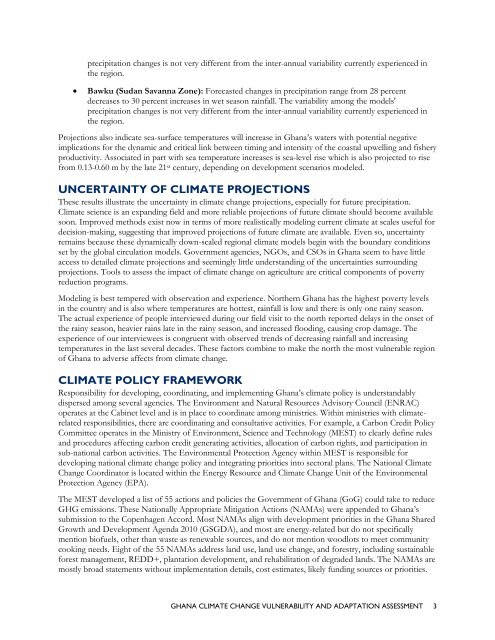ghana climate change vulnerability and adaptation assessment
ghana climate change vulnerability and adaptation assessment
ghana climate change vulnerability and adaptation assessment
- No tags were found...
Create successful ePaper yourself
Turn your PDF publications into a flip-book with our unique Google optimized e-Paper software.
precipitation <strong>change</strong>s is not very different from the inter-annual variability currently experienced inthe region.Bawku (Sudan Savanna Zone): Forecasted <strong>change</strong>s in precipitation range from 28 percentdecreases to 30 percent increases in wet season rainfall. The variability among the models'precipitation <strong>change</strong>s is not very different from the inter-annual variability currently experienced inthe region.Projections also indicate sea-surface temperatures will increase in Ghana’s waters with potential negativeimplications for the dynamic <strong>and</strong> critical link between timing <strong>and</strong> intensity of the coastal upwelling <strong>and</strong> fisheryproductivity. Associated in part with sea temperature increases is sea-level rise which is also projected to risefrom 0.13-0.60 m by the late 21 st century, depending on development scenarios modeled.UNCERTAINTY OF CLIMATE PROJECTIONSThese results illustrate the uncertainty in <strong>climate</strong> <strong>change</strong> projections, especially for future precipitation.Climate science is an exp<strong>and</strong>ing field <strong>and</strong> more reliable projections of future <strong>climate</strong> should become availablesoon. Improved methods exist now in terms of more realistically modeling current <strong>climate</strong> at scales useful fordecision-making, suggesting that improved projections of future <strong>climate</strong> are available. Even so, uncertaintyremains because these dynamically down-scaled regional <strong>climate</strong> models begin with the boundary conditionsset by the global circulation models. Government agencies, NGOs, <strong>and</strong> CSOs in Ghana seem to have littleaccess to detailed <strong>climate</strong> projections <strong>and</strong> seemingly little underst<strong>and</strong>ing of the uncertainties surroundingprojections. Tools to assess the impact of <strong>climate</strong> <strong>change</strong> on agriculture are critical components of povertyreduction programs.Modeling is best tempered with observation <strong>and</strong> experience. Northern Ghana has the highest poverty levelsin the country <strong>and</strong> is also where temperatures are hottest, rainfall is low <strong>and</strong> there is only one rainy season.The actual experience of people interviewed during our field visit to the north reported delays in the onset ofthe rainy season, heavier rains late in the rainy season, <strong>and</strong> increased flooding, causing crop damage. Theexperience of our interviewees is congruent with observed trends of decreasing rainfall <strong>and</strong> increasingtemperatures in the last several decades. These factors combine to make the north the most vulnerable regionof Ghana to adverse affects from <strong>climate</strong> <strong>change</strong>.CLIMATE POLICY FRAMEWORKResponsibility for developing, coordinating, <strong>and</strong> implementing Ghana’s <strong>climate</strong> policy is underst<strong>and</strong>ablydispersed among several agencies. The Environment <strong>and</strong> Natural Resources Advisory Council (ENRAC)operates at the Cabinet level <strong>and</strong> is in place to coordinate among ministries. Within ministries with <strong>climate</strong>relatedresponsibilities, there are coordinating <strong>and</strong> consultative activities. For example, a Carbon Credit PolicyCommittee operates in the Ministry of Environment, Science <strong>and</strong> Technology (MEST) to clearly define rules<strong>and</strong> procedures affecting carbon credit generating activities, allocation of carbon rights, <strong>and</strong> participation insub-national carbon activities. The Environmental Protection Agency within MEST is responsible fordeveloping national <strong>climate</strong> <strong>change</strong> policy <strong>and</strong> integrating priorities into sectoral plans. The National ClimateChange Coordinator is located within the Energy Resource <strong>and</strong> Climate Change Unit of the EnvironmentalProtection Agency (EPA).The MEST developed a list of 55 actions <strong>and</strong> policies the Government of Ghana (GoG) could take to reduceGHG emissions. These Nationally Appropriate Mitigation Actions (NAMAs) were appended to Ghana’ssubmission to the Copenhagen Accord. Most NAMAs align with development priorities in the Ghana SharedGrowth <strong>and</strong> Development Agenda 2010 (GSGDA), <strong>and</strong> most are energy-related but do not specificallymention biofuels, other than waste as renewable sources, <strong>and</strong> do not mention woodlots to meet communitycooking needs. Eight of the 55 NAMAs address l<strong>and</strong> use, l<strong>and</strong> use <strong>change</strong>, <strong>and</strong> forestry, including sustainableforest management, REDD+, plantation development, <strong>and</strong> rehabilitation of degraded l<strong>and</strong>s. The NAMAs aremostly broad statements without implementation details, cost estimates, likely funding sources or priorities.GHANA CLIMATE CHANGE VULNERABILITY AND ADAPTATION ASSESSMENT 3
















